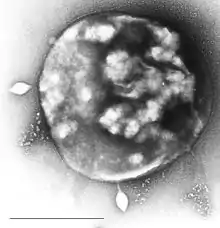Sulfolobales
In taxonomy, the Sulfolobales are an order of the Thermoprotei.[1]
| Sulfolobales | |
|---|---|
 | |
| Electron micrograph of Sulfolobus infected with Sulfolobus virus STSV1. Bar = 1 μm. | |
| Scientific classification | |
| Domain: | |
| Kingdom: | |
| Phylum: | |
| Class: | |
| Order: | Sulfolobales Stetter, 1989 |
| Family | |
DNA transfer
Exposure of Sulfolobus solfataricus to the DNA damaging agents UV-irradiation, bleomycin or mitomycin C induces cellular aggregation.[2] Other physical stressors, such as pH or temperature shift, do not induce aggregation, suggesting that induction of aggregation is caused specifically by DNA damage. Ajon et al.[3] showed that UV-induced cellular aggregation mediates chromosomal marker exchange with high frequency. Recombination rates exceeded those of uninduced cultures by up to three orders of magnitude. Frols et al.[2][4] and Ajon et al.[3] hypothesized that the UV-inducible DNA transfer process and subsequent homologous recombinational repair represents an important mechanism to maintain chromosome integrity. This response may be a primitive form of sexual interaction, similar to the more well-studied bacterial transformation that is also associated with DNA transfer between cells leading to homologous recombinational repair of DNA damage. In another related species, Sulfolobus acidocaldarius, UV-irradiation also increases the frequency of recombination due to genetic exchange.[5]
The ups operon
The ups (UV-induced pilus) operon of Sulfolobus species is highly induced by UV irradiation. The pili encoded by this operon are employed in promoting cellular aggregation, which is necessary for subsequent DNA exchange between cells, resulting in homologous recombination.[6]
A study of the Sulfolobales acidocaldarius ups operon showed that one of the genes downstream of the operon, saci-1497, encodes an endonuclease III that nicks UV-damaged DNA; and another gene of the operon, saci-1500, encodes a RecQ-like helicase that is able to unwind homologous recombination intermediates such as Holliday junctions.[6] It was proposed that Saci-1497 and Saci-1500 function in an homologous recombination-based DNA repair mechanism that uses transferred DNA as a template.[6] Thus it is thought that the ups system in combination with homologous recombination provide a DNA damage response which rescues Sulfolobales from DNA damaging threats.[6]
References
- See the NCBI webpage on Sulfolobales. Data extracted from the "NCBI taxonomy resources". National Center for Biotechnology Information. Retrieved 2007-03-19.
- Fröls S, Ajon M, Wagner M, Teichmann D, Zolghadr B, Folea M, Boekema EJ, Driessen AJ, Schleper C, Albers SV (2008). "UV-inducible cellular aggregation of the hyperthermophilic archaeon Sulfolobus solfataricus is mediated by pili formation" (PDF). Mol. Microbiol. 70 (4): 938–52. doi:10.1111/j.1365-2958.2008.06459.x. PMID 18990182.
- Ajon M, Fröls S, van Wolferen M, Stoecker K, Teichmann D, Driessen AJ, Grogan DW, Albers SV, Schleper C (2011). "UV-inducible DNA exchange in hyperthermophilic archaea mediated by type IV pili" (PDF). Mol. Microbiol. 82 (4): 807–17. doi:10.1111/j.1365-2958.2011.07861.x. PMID 21999488.
- Fröls S, White MF, Schleper C (2009). "Reactions to UV damage in the model archaeon Sulfolobus solfataricus". Biochem. Soc. Trans. 37 (Pt 1): 36–41. doi:10.1042/BST0370036. PMID 19143598.
- Wood ER, Ghané F, Grogan DW (1997). "Genetic responses of the thermophilic archaeon Sulfolobus acidocaldarius to short-wavelength UV light". J. Bacteriol. 179 (18): 5693–8. doi:10.1128/jb.179.18.5693-5698.1997. PMC 179455. PMID 9294423.
- van Wolferen M, Ma X, Albers SV (2015). "DNA Processing Proteins Involved in the UV-Induced Stress Response of Sulfolobales". J. Bacteriol. 197 (18): 2941–51. doi:10.1128/JB.00344-15. PMC 4542170. PMID 26148716.
Further reading
Scientific journals
- Judicial Commission of the International Committee on Systematics of Prokaryotes (2005). "The nomenclatural types of the orders Acholeplasmatales, Halanaerobiales, Halobacteriales, Methanobacteriales, Methanococcales, Methanomicrobiales, Planctomycetales, Prochlorales, Sulfolobales, Thermococcales, Thermoproteales and Verrucomicrobiales are the genera Acholeplasma, Halanaerobium, Halobacterium, Methanobacterium, Methanococcus, Methanomicrobium, Planctomyces, Prochloron, Sulfolobus, Thermococcus, Thermoproteus and Verrucomicrobium, respectively. Opinion 79". Int. J. Syst. Evol. Microbiol. 55 (Pt 1): 517–518. doi:10.1099/ijs.0.63548-0. PMID 15653928.
- Driessen, Arnold; Yang, Nuan (January 8, 2014). "Deletion of cdvB paralogous genes of Sulfolobus acidocaldarius impairs cell division". Extremophiles. 18 (2): 331–339. doi:10.1007/s00792-013-0618-5. PMID 24399085.
- Euzeby JP; Tindall BJ (2001). "Nomenclatural type of orders: corrections necessary according to Rules 15 and 21a of the Bacteriological Code (1990 Revision), and designation of appropriate nomenclatural types of classes and subclasses. Request for an Opinion". Int. J. Syst. Evol. Microbiol. 51 (Pt 2): 725–727. doi:10.1099/00207713-51-2-725. PMID 11321122.
- Cavalier-Smith, T (2002). "The neomuran origin of archaebacteria, the negibacterial root of the universal tree and bacterial megaclassification". Int. J. Syst. Evol. Microbiol. 52 (Pt 1): 7–76. doi:10.1099/00207713-52-1-7. PMID 11837318.
Scientific books
- Reysenbach, A-L (2001). "Class I. Thermoprotei class. nov.". In DR Boone; RW Castenholz (eds.). Bergey's Manual of Systematic Bacteriology Volume 1: The Archaea and the deeply branching and phototrophic Bacteria (2nd ed.). New York: Springer Verlag. p. 169. ISBN 978-0-387-98771-2.
- Stetter, KO (1989). "Order III. Sulfolobales ord. nov. Family Sulfolobaceae fam. nov.". In JT Staley; MP Bryant; N Pfennig; JG Holt (eds.). Bergey's Manual of Systematic Bacteriology. 3 (1st ed.). Baltimore: The Williams & Wilkins Co. p. 169.